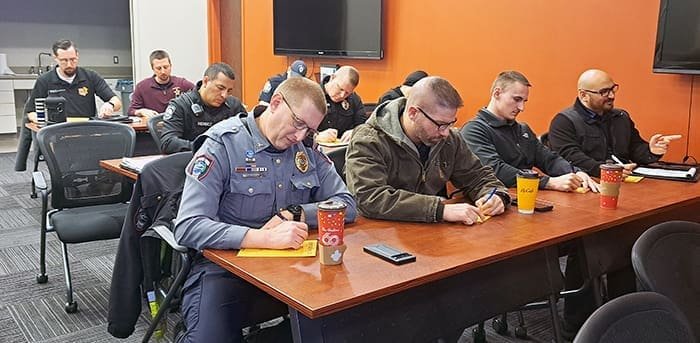
By: Anna Wozniak
THE VILLAGE REPORTER
anna@thevillagereporter.com
This last week saw the police of Williams County come together to review their basic policies and procedures and undergo necessary training.
This training is geared specifically towards filling the gaps noticed during county-wide scenario training that took place in November.
These trainings have been implemented by Sheriff Kochert since he took office in order to help elevate the standards of the police departments across the county, trying to ensure that there is consistency between how the officers are responding to and interacting with the community.
These trainings go in four phases, with training following up scenario training to elevate the knowledge shared by all officers in Williams County.
This is designed by Sheriff Tom Kochert, as he analyzes the scenario trainings to determine what the county could improve upon.
He then writes a training curriculum, so that the training hours required by the state annually for all officers can be used towards elevating the state of Williams County officers as a whole.
Officers first touched on crime scene investigations with Williams County Detective Ben Baldwin, and changes to how policing has been conducted throughout the years.
From changing equipment and huge technological advancements, tenured officers have had to adapt to a multitude of changes to the same basic investigative procedures.
The purpose of an investigation is to gather evidence and determine whether a crime has happened. A crime scene is a location that relates to the crime that was committed, and it is important that these scenes be accurately documented so that convictions hold up under the high scrutiny of the court.
One way to make sure a conviction holds is to be sure that all relevant and valuable evidence is collected properly.
The number one responsibility at a crime scene is officer safety, followed closely by potentially rendering aid and securing the scene of the crime.
Interacting with witnesses was the last primary responsibility listed to the trainees, with it being highlighted that a major part of an officer’s job is to speak with members of the community.
Then, the basic steps of scene processing were discussed, with it being stressed that there are a lot more semantics to processing that can be determined by asking an expert in the field.
Officers begin processing by assessing, observing, documenting, searching, collecting, and processing / analyzing the scene and information available to them.
Sheriff Kochert added that it is important that officers don’t go into a crime scene with preconceived notions of what may have happened, and to always let the evidence provide for the analysis of the crime.
There are four main things that officers must consider pertaining to proximity when photographing a crime scene are the different ranges.
Officers are encouraged to take photographs from a distance, then from mid-range, go in for closeups, and end with closeups featuring a scale.
It was then highlighted that the purpose of taking photographs is to tell the story of what happened, with examples being provided of both some useful, and not so useful, crime scene photos relating to breaking and entering.
Physical evidence is crucial when getting convictions, and can help with reconstruction, determining statement accuracy, and determining the occurrence of a crime.
Different kinds of evidence that can be collected were then discussed, with turnaround times on different kinds of evidence highlighted to help officers to obtain lab results in the fastest fashion possible.
It was shared that fingerprint training will happen on April 3, 2024, and the different types of packaging and chain of custody procedures for evidence were discussed.
Officers then conducted a practical exercise, wherein the information that was just given on collecting and preparing evidence was tested.
Proper procedure for collecting statements was then discussed, with the information separated by witness statements, victim statements, and suspect statements.
The sheriff’s office then welcomed officers to share ideas on future CPT trainings, with ideas and instructor recommendations welcomed before it was announced that May will soon see a two-day course that will see county officers able to undergo more training.
Prosecutor Katie Zartman then came in and began the second portion of the training, which provided training for officers tailored around how the judicial system works.
First discussed was avoiding suppression of evidence, which can first and foremost be protected by always respecting the fourth amendment on reasonable searches following probable cause.

Expectations of privacy are subjective and can be attributed to each person’s state of mind. Objective expectations are ones that have been definitively established by the courts as objectively reasonable.
The fourth amendment is important because of the exclusionary rule, and if the fourth amendment is violated, the information and evidence gathered thereafter or related to the illegally obtained evidence are inadmissible and will not be allowed in court.
Probable cause was then discussed, with it being explained that officers have a responsibility to articulate why they have a fair probability to believe that a crime has occurred, evidence of a crime exists, and that the evidence is at the location that is wanting to be searched in order to be awarded a search warrant.
Probable cause is also subjective, with officer training and experience being taken into account.
Case law has created some exceptions to requiring a warrant for a search or seizure, with exceptions to the warrant rule being further discussed.
Items in plain view do not need a warrant, but this does not apply to items that are thought to be stolen. If the item must be moved to confirm the ownership of the object, a warrant is needed.
Things may be seized if it is thought that there is the possibility of destruction of evidence, but that a warrant is still needed before searching through these seized items once probable cause for seizing them is defined.
A consent search, voluntarily authorized by someone who has the legal authority to do so, is another exception to the need for a search warrant.

Consent for this can be revoked at any time, and officers are encouraged to get a signature from the consenting person in the consent search warning so that it is harder to falsify.
Exigent circumstances were then discussed, with Prosecutor Zartman sharing that these are judged off of the premise if another officer could reasonably come to the same conclusion / decision in the event of the emergency.
Vehicle stops are, in and of themselves, a seizure. Probable cause is therefore necessary before stopping a vehicle, but because vehicles are mobile, they have a legal exception to the warrant requirement to help stop the transport of illicit goods.
The ability to search without a warrant also applies to closed containers and personal possessions of pulled over individuals.
A vehicle inventory search is undertaken to note personal property, but this search is not for the purpose of finding evidence or contraband, although a record is made of what is found.
Parameters around using a K9 officer during a traffic stop were then discussed, with it being shared that reasonable suspicion is necessary to make those involved wait on the K9 officer to conduct a search.
Prosecutor Zartman then shared that her department will be doing more research into K9 probable cause and will share it with the county’s K9 officers.
Discussion was then held on probable cause for impairment, with it being shared that proving impairment is the biggest part of obtaining probable cause.

Search incidents to arrest warrant exceptions are only in the area immediately around the arrestee, to secure the area to which they have direct access.
Terry Stops, another exception to the warrant rule, outlines how a person under reasonable suspicion of a crime can be searched for officer safety to ensure that they are not armed and dangerous.
If a weapon is visible in a vehicle, the officer may search the vehicle to ensure that there are no other weapons inside of the vehicle.
The fifth amendment was then spoken on, with Miranda Rights being outlined in the Miranda v. Arizona case.
Miranda warnings are required for subjects in custody or interrogation. Interrogation was illuminated to also include any words or actions that are likely to elicit an incriminating response.
Officers then went through example scenarios designed to test their knowledge of Miranda warnings and custody.
Different ways suspects can invoke their rights were discussed, helping to ensure officers understand the legal process for interviews.
Confessions are often under scrutiny for being voluntary, and parameters of voluntariness were then detailed to the present officers.
When it comes to trust with the judicial system, it was shared that credibility is everything, and that officers that can be trusted not to violate the law will be trusted by the courts when they testify.
Zartman was thanked for her presentation before Ohio State Trooper Edwards came in to review proper search protocol for officers.
Trooper Edwards gave a demonstration of how a slow methodical search done in quadrants can be done to ensure that all areas are properly searched.
The officers were reminded that it is important to use the same amount of force, time, and attention with searches on those of all sexes, and a demonstration was given on how frisk searches are to be conducted on each sex.
This training was offered at the East Annex, and was offered on Tuesday, Wednesday, and Thursday of last week.
Sheriff Kochert shared that by offering the training multiple times a week, they hope to ensure that officers from all over the county can attend without putting too much of a strain on the rest of the department.
He also shared that this should see a rise in basic standards across all departments in the county, with the goal of seeing the behavior of the officers uniform throughout.



